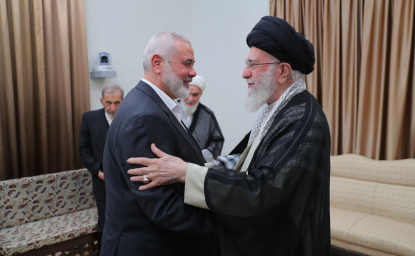Al Qaeda’s Latest Rebranding: Hay’at Tahrir al Sham
Al Qaeda in Syria has rebranded itself yet again. On January 28, 2017, it merged with four smaller Syrian factions to create the new Hay’at Tahrir al Sham (HTS).
Al Qaeda in Syria has rebranded itself yet again. On January 28, 2017, it merged with four smaller Syrian factions to create the new Hay’at Tahrir al Sham (HTS).

Al Qaeda in Syria has rebranded itself yet again. The original group, known as the Nusra Front was formed in 2012. It changed its name to Jabhat Fatah al Sham in mid-2016. On January 28, 2017, it merged with four smaller Syrian factions to create the new Hay’at Tahrir al Sham (HTS). The move tripled its forces to some 31,000 fighters. It also strengthened its hand militarily, expanding its presence from one front to operations in Idlib, Hama and Aleppo in the north and Daraa in the south. It makes the larger group more dangerous and possibly harder to expel.
The merger was produced in part by infighting between the two leading rebel factions—JFS and Ahrar al Sham—forcing smaller militias to align with one or the other. JFS came out ahead. It also coincided with Russian-orchestrated Syrian peace talks in Kazakhstan.
The third iteration of al Qaeda in Syria reflects its strategy to broaden its local appeal and deepen its control of the rebel campaign. The formation of HTS will allow the al Qaeda affiliate to operate in wider swaths of territory once held by militias now under its umbrella.
As with previous rebranding initiatives, HTS is also trying to disassociate itself from al Qaeda, which is seen as toxic by other rebel groups as well as the local civilian population. But a new name has not altered its image.
Hay’at Tahrir al Sham, or the Organization for the Liberation of the Levant, was created from five groups operating in northern Syria. They represent the full spectrum of ideologies, from moderates to hardline extremism. They include:
● JFS (Front for the Conquest of Syria),
● Harakat Nour al Din al Zinki (The Movement of Nour al Din al Zinki),
● Liwa al Haq (The Truth Brigade),
● Jabhat Ansar al Din (Supporters of the Religion Front),
● and Jaysh al Sunna (Sunna Army).
The merger was announced on the messaging app Telegram. The app is often used by extremist organizations, including ISIS and al Qaeda, because transmissions are encrypted.
Harakat Nour al Din al Zinki was considered a moderate group. As one of the oldest and strongest groups within the moderate Free Syrian Army (FSA), it helped expel ISIS from Aleppo in 2014. It was also once considered a CIA-“vetted” group; it even received U.S.-made anti-TOW missiles. However, the United States—as part of the Friends of Syria Group—stopped arming the Zinki Movement in early 2015, forcing it to ally with more militant movements. It originally joined the more extreme Jaysh al Fatah, or Army of Conquest, an alliance of several rebel groups that drove the regime from Idlib province, before ultimately merging with the reincarnated HTS. Zinki was one of the largest factions to merge with HTS, bringing an estimated 7,000 fighters to its ranks.
In July 2017, Harakat Nour al Din al Zinki announced its break from Hay’at Tahrir al Sham. Zinki cited the infighting between HTS and Ahrar al Sham as the primary reason for the split.
Jaysh al Sunna, which is primarily based in Homs, has a similar story to the Zinki Movement. It was also initially affiliated with the moderate U.S.-backed Free Syrian Army. But in 2015, it too joined the rebel Jaysh al Fatah coalition.
Liwa al Haq, an Islamist militia, was formed in 2012 in Homs. It operates in the provinces of Idlib, Aleppo and Hama. It wants to establish Sharia law in Syria. It had also been a member of the Army of Conquest.
Jabhat Ansar al Din and JFS represent the most hardline militias that have joined HTS. Jabhat Ansar al Din—a jihadi coalition of four groups—was formed in 2014. It claimed to be independent even though it had ties to al Qaeda.
Jabhat Fatah al Sham (JFS), originally the Nusra Front, was formed in 2016. It operated mainly in Idlib Province. It was considered the second strongest insurgent group after the Islamic State of Iraq and Syria, also known as ISIS or ISIL. JFS founders included senior al Qaeda member Abu Bakr al-Baghdadi, who serves as the current head of the Islamic State. It is a designated terrorist organization by the United States and the United Nations.
Since 2012, the various incarnations of al Qaeda’s Syrian affiliate have struggled to gain credibility as a legitimate local movement. Nusra Front leader Abu Mohammed al Julani (left)tried and failed to create a broad alliance with other Islamist rebels. But they shied away from being tainted by an al Qaeda connection. In July 2016, the Nusra Front changed its name and Julani vowed that it no longer had any affiliation with groups outside of Syria.
In practice, however, Jabhat Fateh al Sham was widely seen as a rebranding ploy. Al Qaeda’s subsequent blessing of the tactical split—and Julani’s insistence there was no ideological shift— only fueled suspicion that the change was purely artificial. “It signaled a return to al Qaeda’s original game plan for Syria,” according to Daveed Gartenstein-Ross and Thomas Joscelyn in Foreign Affairs.
In its first video message, in February 2017, HTS also claimed that it is independent. But that claim was put into question by the backing of several prominent jihadist clerics, notably Abdullah al Muhaysini, a suspected senior al Qaeda Sharia official. Al Julani’s appearance as General Military Commander in a new HTS video cast further doubt on the al Qaeda break.
The new rebel group is headed by Abu Jaber Hashim al Sheikh (left). The “Engineer,” as he is known, was born in 1968 in a suburb of Aleppo. He received his bachelor’s degree in mechanical engineering from the University of Aleppo and worked in the defense industry. But al Sheikh was frequently arrested due to his Salafi-jihadist beliefs. He was imprisoned in the infamous Sednaya military prison from 2005 until 2011. After the uprising, Hashim al Sheikh joined and eventually became a senior leader in the Free Syrian Army’s Al Fajr Islamic Movement. His unit reportedly fought alongside the Nusra Front until it eventually assimilated into Ahrar al Sham.
At least 3,000 of the HTS fighters were Ahrar al Sham defectors. They include high-ranking military officers, a military spokesperson, and a judge. The Ahrar group responsible for manufacturing weapons in Idlib province was another major Ahrar defection. Hashim al Sheikh, who spurred the defections, cites the HTS merger as a necessary step towards uniting “the Syrian factions under a single unified command.”
The creation of HTS reflects the deepening ideological and tactical split among Islamist movements within the Syrian insurgency. The defection of Abu Jaber and other high-ranking officials from Ahrar al Sham underscores the division between two ideologies. On one side is the mainstream ideology of Ahrar al Sham and the Muslim Brotherhood. On the other is HTS and al Qaeda, who are Salafi jihadis.
Both advocate Sharia law as the primary source of legislation. But mainstream Islamists like the Muslim Brotherhood favor a gradualist approach in obtaining a Sharia-based civil state; they do not advocate theocratic rule. Salafi jihadis, like al Qaeda, want to recreate a Caliphate; they believe the only way to do so is by carrying out armed struggle against the enemies of Islam.
“The formation of the HTS has caused sharp polarization between the armed factions in northern Syria,” Abdullah Suleiman Ali, a Syrian specialist in jihadist movements, told Al-Monitor. “The new dispute between the two jihadist groups stresses the deep ideological and political gap between [JFS and Ahrar al Sham] after many failed attempts to merge.”
HTS leader al Sheikh has repeatedly rejected a peace agreement that allows Assad—whom he referred to as “the butcherer”—to stay in power. The group has refused to be represented by the High Negotiating Committee (HNC), which served as the rebels’ diplomatic representative in October 2015 at an opposition conference in Riyadh. It views the HNC as a Western pawn. It has not participated in any peace initiatives. In January 2017, it attacked the sites of factions that participated in the Astana peace talks.
More than anything else, the creation of HTS proves both al Qaeda’s tactical prowess and its political resilience—with implications for the outside world as well. “Al Qaeda now has a broader coalition, with tens of thousands of fighters who are being exposed to its ideology and outlook,” said Daveed Gartenstein-Ross. “It is now all the more difficult for the United States to fight al Qaeda in Syria without being seen as fighting against the Syrian revolution writ large.”
At the same time, HTS is still vulnerable, politically and militarily. Previous mergers have ultimately ended in fractionalization. This one could also be short lived; it could dissolve into its former factions. Although HTS has expanded its reach, ISIS is still a larger force. The al Qaeda franchise does not have airpower to challenge either U.S. warplanes or the Syrians and their Russian backers. And it still faces opposition even in the areas where it is now the strongest.
On May 18, 2017, al Qaeda disowned Hayat Tahrir al Sham as an official affiliate, according to Western analysts. “Al Qaeda disagrees very strongly about Tahrir al-Sham’s vision and is giving up on rescuing it,” a senior Islamic military commander told Charles Lister of the Middle East Institute.
Since it was founded in 1988, al Qaeda has advocated global jihad, but Hayat Tahrir al Sham fought a nationalist struggle limited to Syria. Al Qaeda leader Ayman al Zawahiri was publicly critical of HTS’s “evil strategy” in an audio statement released by al Qaeda’s propaganda outlet, As Sahab, on April 23, 2017:
“[Some] wish to deceive you into buying the myth that only if you were to change your jihad to an exclusively nationalist Syrian struggle, [then] the leading international criminals would be pleased with you.”
“The cause of the Sham [Levant] is the cause of the entire Ummah [Muslim nation]. We must not present it as merely a cause of the people of the Sham, and then further narrow it down to a cause of Syrians alone, for this is precisely the enemy’s plan and his much sought after objective.”
“The enemy seeks to transform the jihad in Sham from a cause of the Muslim Ummah to an exclusively nationalist Syrian cause, then turn the nationalist cause to an issue of specific regions and localities, and finally reduce this to an issue of a few cities, villages and neighborhoods. [It] is incumbent upon us to confront this evil strategy by declaring that the jihad in Sham is the jihad of the Muslim Ummah aimed at establishing the rule of Allah in the land of Allah. This must coincide with encouraging the entire Ummah to participate in the jihad of Sham with its sons, wealth, efforts, and energies.”
Al Qaeda cited two other reasons for the split. “HTS has accepted insufficient levels of purity in its structure, rhetoric, vision, and practice,” Lister said. “Its core leadership has allegedly violated its oath of religious loyalty to al Qaeda leader Ayman al Zawahiri.”
HTS and Zawahiri have clashed before. The Nusra Front publicly broke from al Qaeda in mid-2016—but without consulting Zawahiri, who refused to accept a split. “Everyone knows that the sage rejected the breaking of ties, which was carried out by deception and the violation of an oath,” said Dr. Abu Hamza, an Arab scholar often quoted by al Qaeda sympathizers.
And tensions continued. Zawahiri has had no direct contact with Jolani since late-2014. Communication was only done through intermediaries an Islamic cleric told Lister. “This is a big problem,” he said. “Jolani has made his own decisions many times, without Zawahiri’s permission. This isn’t the first problem they have had, but it is the most significant.”
Since the split, al Qaeda has reportedly been trying to create a new faction in Syria’s northern Idlib Province, its most active theater of operations. Tahrir al Sham has tried to disrupt al Qaeda’s mobilization.
Idlib has the potential to turn into a battleground between al Qaeda and its former affiliate. Yet analysts speculate that the two groups may distance themselves from each other. “Al Qaeda simply does not appear to have the resources or the need to initiate active hostility with HTS,” Lister said “It is more likely to continue and distance itself through condemnation and criticism, while gradually attempting to build a capable loyalist jihadi movement of its own.”
As of June 2017, the State Department said it still considered HTS and al Qaeda to be one and the same organization. “We believe these actions are an al Qaeda play to bring as much of the Syrian opposition under its operational control as possible, thereby making groups that merge with HTS part of al Qaeda’s Syria network,” said spokesperson Nichole Thompson. Yet neither the United States nor Canada have designated HTS as a terrorist organization.
Mattisan Rowan was a research assistant at the Woodrow Wilson International Center for Scholars.

Learn more about Hamas and how it relates to similarly aligned organizations throughout the region. Read more



